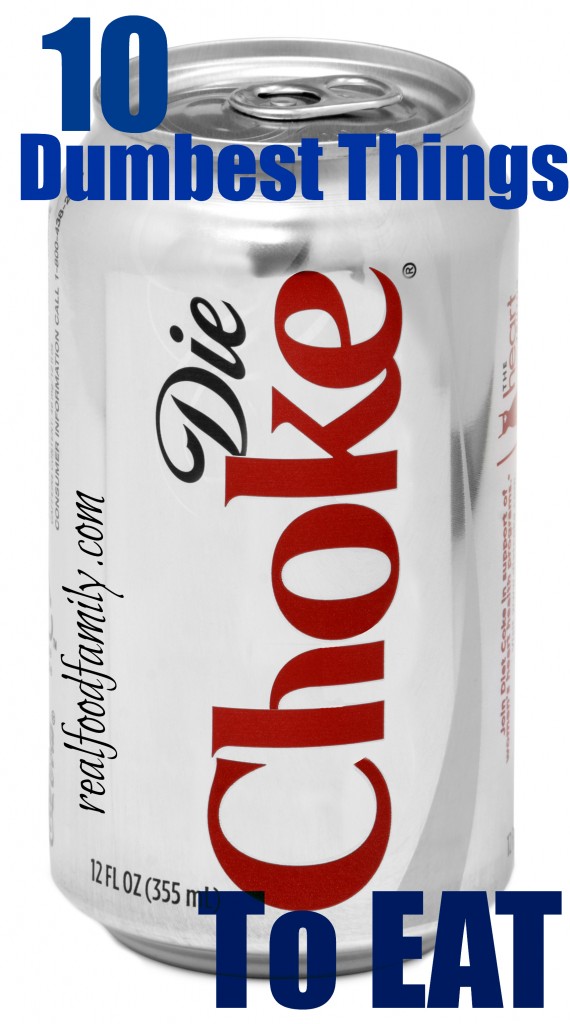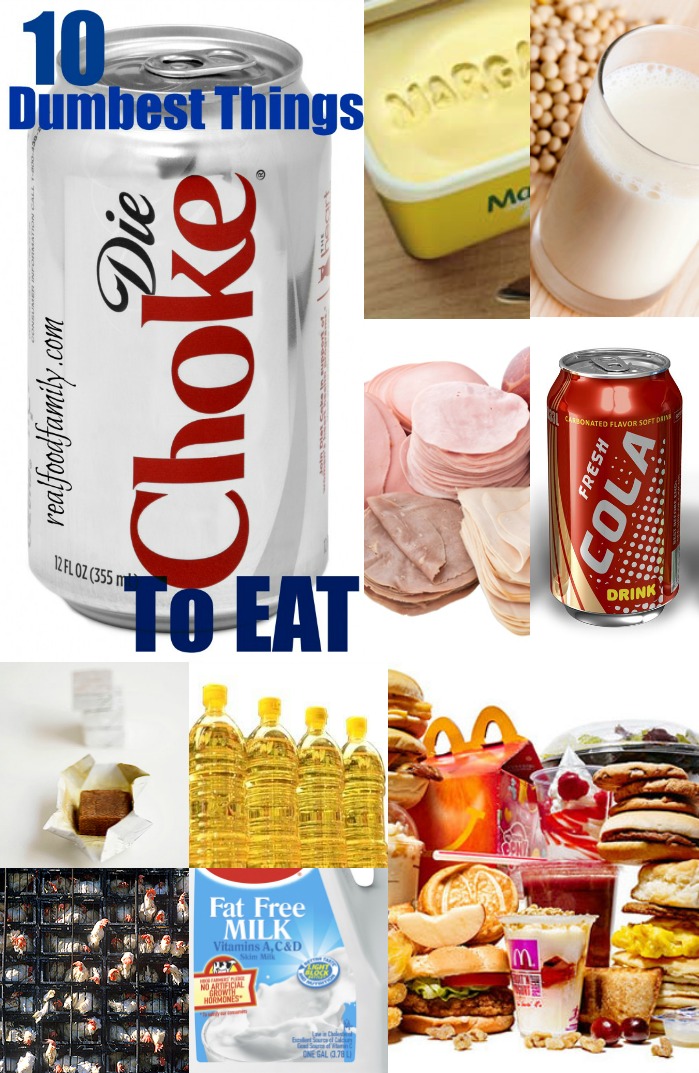 This was a difficult list to put together, only because there were so many more foods I wanted to add. Pretty much 90% or more of what you find in a supermarket isn’t actually “food” and therefore should be included on the dumbest foods list, but I tried to form a good general list to get you started. These are the foods that make me cringe when I see people eating them…especially pregnant women or children.
This was a difficult list to put together, only because there were so many more foods I wanted to add. Pretty much 90% or more of what you find in a supermarket isn’t actually “food” and therefore should be included on the dumbest foods list, but I tried to form a good general list to get you started. These are the foods that make me cringe when I see people eating them…especially pregnant women or children.
You can also check out my list of the 10 BEST Foods to Eat.
1. Soft Drinks
Even if corn syrup and cane sugar are “the same” (as the Corn Refiner’s Association is trying so desperately to make you believe, even though it is an absolute lie- http://articles.mercola.com/sites/articles/archive/2008/11/13/corn-syrup-s-new-disguise.aspx), Americans have chosen to replace drinking water with sugar-loaded commercial soft drinks that act like poison elixirs- decaying the body as they are consumed en mass. Americans are washing down their daily meals with concentrated high-fructose corn syrup without any thought to how much damage they could actually be doing to their bodies.
We aren’t against a nice, old fashioned, artisan soda pop as a treat every now and then, but water should be what we drink when we are thirsty, otherwise we are working against our body’s cries for hydration.
Excessive sugar intake is indicated in most modern degenerative diseases, and is probably one of the greatest culprits of the obesity and preventable diseases plaguing our culture. We suck down sugar in the form of soft drinks more than any other beverage. According to US News and World Reports, in 1967, Americans ate 114 pounds of sugar and sweeteners a year per capita, nearly all of it as either raw or refined sugar. In 2003, each person consumed about 142 pounds of sugar per year…and that report is over a decade old! Since high-fructose corn syrup was developed more than 30 years ago, consumption of the sweetener, which flavors everything from soda pop to ranch dressing, has skyrocketed. Now Americans each down about 61 pounds a year of corn syrup alone. Since 1950, soft-drink consumption per capita has quadrupled, from about 11 gallons per year to about 46 gallons in 2003–nearly a gallon a week per person.” (http://health.usnews.com/usnews/health/articles/050328/28sugar.b.htm) In addition, the phosphoric acid used to carbonate soft drinks breaks down the mineral absorption process, necessary for most functions within the body, especially those pertaining to bone health and digestion. What is absolutely despicable is that children are irresponsibly being served these death drinks every day- before they can even walk. There is no benefit to commercial soft drinks and regular consumption can be dangerous.
2. Diet Soft Drinks
If there is a drink I prefer that someone consume LESS than regular soft drinks, it’s diet soft drinks. Talk about a useless “food”! In addition to the damaging effects of phosphoric acid for carbonation, the real poison in this food is the artificial sweetener. Aspartame is usually the sweetener used for diet products, and the FDA has over 90 documented side effects caused by aspartame, including headaches/migraines, dizziness, seizures, nausea, numbness, muscle spasms, weight gain, rashes, depression, fatigue, irritability, tachycardia, insomnia, vision problems, hearing loss, heart palpitations, breathing difficulties, anxiety attacks, slurred speech, loss of taste, tinnitus, vertigo, memory loss, and joint pain. Aspartame may also trigger or worsen conditions like brain tumors, multiple sclerosis, epilepsy, chronic fatigue syndrome, parkinson’s disease, alzheimer’s, mental retardation, lymphoma, birth defects, fibromyalgia, and diabetes.
Ongoing research is raising more serious concerns for consuming this non-food:
- Artificial sweetener linked to weight gain (2017)
- Carcinogenic effects of artificial sugar (2014)
- Artificial sugars and cancer association
Learn more and get more sources at http://aspartame.mercola.com or http://www.westonaprice.org/modern-foods/570-sugar-free-blues.html. It shouldn’t be too difficult to realize that diet soft drinks are a brain-dead choice to make…that is, unless you’ve already had too much.
3. Hydrogenated Oils (Margarine and Vegetable Shortening)
Do you know what hydrogenated oil is? “The process of partial hydrogenation produces trans fats by straightening out the unsaturated molecules through rearrangement of the hydrogen atoms at the position of the double bond. These altered fats are solid at room temperature and so can be used in commercial baked goods and for frying. Trans fatty acids have been increasingly implicated as contributing to cancer, heart disease, auto-immune disease, tendon and bone degeneration and problems with fertility and growth. Trans fatty acids in partially hydrogenated vegetable oils are the main cause of type 2 diabetes, characterized by high levels of both insulin and glucose in the blood, because they inhibit the insulin receptors in the cell membranes.” (http://www.westonaprice.org/know-your-fats/556-interesterification.html) Butter is better!
Read on: http://www.westonaprice.org/food-features/519-why-butter-is-better.html
4. Vegetable Oil (Canola, Soybean, Corn, Cottonseed, etc.)
If you are like most Americans, you have been brainwashed into believing that saturated fat is bad and vegetable oil is the good choice. Well, I’m sorry to tell you that this is an absolute myth. It is true that heart disease, diabetes, and other inflammatory diseases are probably caused in part by fat consumption, but not the fat that you’re thinking of. Unfortunately, it is the fats Americans have been droned into believing are “heart healthy” that are destroying this vital blood pumping muscle. The inflammatory process in the body relies on a balance of fatty acids- some inflammatory, some anti-inflammatory. (We actually want the ability to inflame sometimes in order to keep balance and fight disease.) Because of America’s obsession with the anti-saturated-fat myth, we have inundated ourselves with these refined unsaturated vegetable oils (mostly via salad dressings and baked goods), which are often rancid from processing and responsible for an excessive amount of omega-6 fatty acids in the body, which puts these bodies in a highly inflammatory state. “Recent research has revealed that too much omega-6 in the diet creates an imbalance that can interfere with production of important prostaglandins. This disruption can result in increased tendency to form blood clots, inflammation, high blood pressure, irritation of the digestive tract, depressed immune function, sterility, cell proliferation, cancer and weight gain”(1). To learn more about this whole fat myth thing, visit: http://www.westonaprice.org/know-your-fats/526-skinny-on-fats.html
5. Soy Milk, Soy Formula, Soy Protein, Soy…
Oh boy, here we go. Shame on you American industry for deciding to take a cheap plant that is barely edible and can barely be digested by the body, processing it, and selling the bi-products of it to your citizens as a “health food”- and, even worse, as an option for feeding babies!!! Listen people, soy food is poisonous unless it is consumed after a long fermenting process, and even then should be consumed in moderation. Modern soy products like soy milk, soy formula, soy proteins, etc., are laden with phyto-estrogens, mineral blocking phytic acid, and harmful enzymes that destroy the digestive tract. Phyto-estrogens are compounds that the body reads as estrogen…so men, drink soy milk if you want boobs! I personally believe that the rise in hormone-related cancers, strange puberty ages and rates, infertility, thyroid problems, severe acne, and other modern human diseases are caused in part by the highly successful marketing campaign to sell soy as a health food. In addition, I believe soy formula for infants should be illegal, as it dramatically damages developmental health. Traditional cultures, especially Asian cultures, must be looking at America laughing, because they’ve always known that you can’t just eat an improperly prepared soy bean. In fact, they’ve made an art out of soy preparation that the Western world has ignored entirely…much like everything else. If you still think soy is a health food, then “baaaa” like a sheep, because you have fallen for yet another American nutrition myth. Learn more about the dangers of soy here: http://www.westonaprice.org/soy-alert.html.
6. Reduced Fat and Ultra-Pasteurized Dairy
Our family drinks about 3 gallons of milk per week…but we avoid pasteurized, reduced-fat dairy like the plague. You can read more about the kind of milk we drink- raw milk- on my “10 Best Foods to Eat” list, but know that raw milk and pasteurized milk are two entirely different foods. When big city populations exploded during the industrial revolution, the people needed to figure out how to get the food they knew was so essential- milk- to the cities, where cows could not graze. They began to cram cows into small areas of land, where grass could not be sustained. Cows were living in their own crap, eating food industry bi-products and waste. They were sick, full of bacteria, and producing milk laden with the disease. When Luis Pasteur discovered how a heating process (pasteurization) could kill harmful bacteria and organisms, he won the Nobel prize. Alas, the citi-folk could drink milk and not die of tuberculosis and other deathly bacterial diseases. While I do believe Pasteur probably deserved the prize because of the role pasteurization has had in keeping people alive, it is sad that so many people ignored that the process would alter the milk in a way that would destroy the beneficial nutrients and make it destructive to human health.
Not only have we ruined milk with pasteurization, but we have had to remove the “harmful” fat from it as well, and alas today we have the watery white liquid called reduced fat, ultra-pasteurized milk, which is what most Americans consume as “dairy”. Pasteurization and ultra pasteurization adulterates milk proteins, destroys vitamins and minerals, and kills the enzymes that make it digestible. This lack of enzymes make it very difficult for the body to digest the milk sugar (lactose), therefore causing digestive distress or “lactose intolerance” for many. To reduce fat in milk, the fat is extracted, highly heated and oxidized into a powder, then blasted back into the milk so that it still looks like milk, but doesn’t have the dreaded “fat grams”. As a result, this “reduced fat” product contains oxidized fat and cholesterol, which are actually the only fats proven to cause heart disease. The fat and cholesterol that existed in the pre-reduced-fat milk was not oxidized and actually was the type of fat that benefits heart health. If you want to cause inflammation and clog your arteries with those oxidized fat and cholesterol molecules, then keep choosing the reduced-fat dairy. Visit www.realmilk.com to learn more.
7. MSG (Non-Homemade Soup, sauce mixes, etc.)
You’ve heard of MSG, but do you really know what that is? “Following the Second World War, food companies also discovered monosodium glutamate (MSG), a food ingredient the Japanese had invented in 1908 to enhance food flavors, including meat-like flavors. Humans actually have receptors on the tongue for glutamate. It is the protein in food that the human body recognizes as meat. Any protein can be hydrolyzed to produce a base containing free glutamic acid or MSG. When the industry learned how to make the flavor of meat in the laboratory, using inexpensive proteins from grains and legumes, the door was opened to a flood of new products including bouillon cubes, dehydrated soup mixes, sauce mixes, TV dinners and condiments with a meaty taste. “Homemade” soup in most restaurants begins with a powdered soup base that comes in a package or can and almost all canned soups and stews contain MSG, often found in ingredients called hydrolyzed proteins. The fast food industry could not exist without MSG and artificial meat flavors to make “secret” sauces and spice mixes that beguile the consumer into eating bland and tasteless food.” (2)
Here is another pathetic example of how we turned a nourishing, time-honored tradition into an adulterated mess. Almost any soup you buy in a store or restaurant is made with time-cutting meat-mimicking powder stocks, which are devoid of any nutritional value. Skip the soup unless you know it was made with a real homemade stock!
8. Fast Food (drive-throughs, gas station food, cheap supermarket food, etc.)
I don’t think I need to go on with this one…or maybe I do. Hamburger meat is usually made from sick, old commercial dairy cows…yuck. Other “meats” from these joints are mostly fillers made with mysterious “parts” of pulverized chickens and other animals…yuck. Fries and fried foods are fried in partially hydrogenated non-food oils like cottonseed oil…who knows how long that grease has been sitting there frying thousands of different peoples’ meals- maybe years…yuck! The baked bread and cake products are generally made from highly processed corn and soy flours, corn syrup, and more hydrogenated non-food oils. The “vegetables” are cheap and most likely genetically modified plants grown with tons of chemical pesticides and artificial fertilizers (or “natural” fertilizer, aka the crap -literally- that is coming from the industrialized animal feed lots). The condiments and other foods are almost entirely made of soy flour, corn syrup and non-food products with virtually no nutritional benefit…yuck! Why waste the calories?! Don’t buy fuel for your body where you buy fuel for your car, and know that pretty much anything you could buy as “food” in a fast food joint is the trash left over from the industrial food industry….can you say, “YUCK!”
9. Table Salt and Salted Meats (Sodium Nitrates and Nitrites)
“I don’t eat salt because it raises my blood pressure.” Okay, I agree. Table salt, or iodized salt sucks. It is man-made and processed with sodium chloride and a high heat process which kills its vitamin and mineral content, then is usually packed with additives, anti-caking agents, and often-times aluminum. You definitely get the salty flavor, but this doesn’t do much for your health. Eliminating salt from the diet isn’t exactly a wise choice, though. Natural sea salt is packed with essential minerals and replenishes your body with the salt it needs to function properly. Mineral rich sea salt balances blood pressure, regulates digestion, and nourishes the adrenal glands. The best salt to buy is Celtic sea salt grown in the northern regions of France or Brittany. It will have a grey color to it. This is usually available at a good grocery store or health food store.
As far as salt-cured meats (sodium nitrates and nitrites), these “salts” often cause digestive distress, particularly pertaining to colon health, and may be a major contributor to colon cancer.
10. Commercially Produced Meat and Animal Foods
I used to be a vegetarian, and for some time, a vegan. Unfortunately it took years of illness, injury, and study to learn that vegetarianism and veganism are not ideal for optimum human health. At the same time, one unfortunate glance at the way commercial meat is raised and produced will most likely make you cry and proclaim that you will never again eat animal products. It is shameful and disgusting. Here is a not-so-harsh source to learn more about the issue in cartoon form: http://www.themeatrix.com. Not only is industrial meat production a sad story, but the resulting product usually contains toxins, antibiotics, artificial hormones, and is nutritionally inferior to the natural, pastured, humanely-raised version.
What would you add to the list?
Cited Sources
- Horrobin, D F, Reviews in Pure and Applied Pharmacological Sciences, Vol 4, 1983, Freund Publishing House, 339-383; Devlin, T M, ed, Textbook of Biochemistry, 2nd Ed, 1982, Wiley Medical, 429-430; Fallon, Sally, and Mary G Enig, PhD, “Tripping Lightly Down the Prostaglandin Pathways,” Price-Pottenger Nutrition Foundation Health Journal, 1996, 20:3:5-8
- http://www.westonaprice.org/food-features/515-broth-is-beautiful.html


